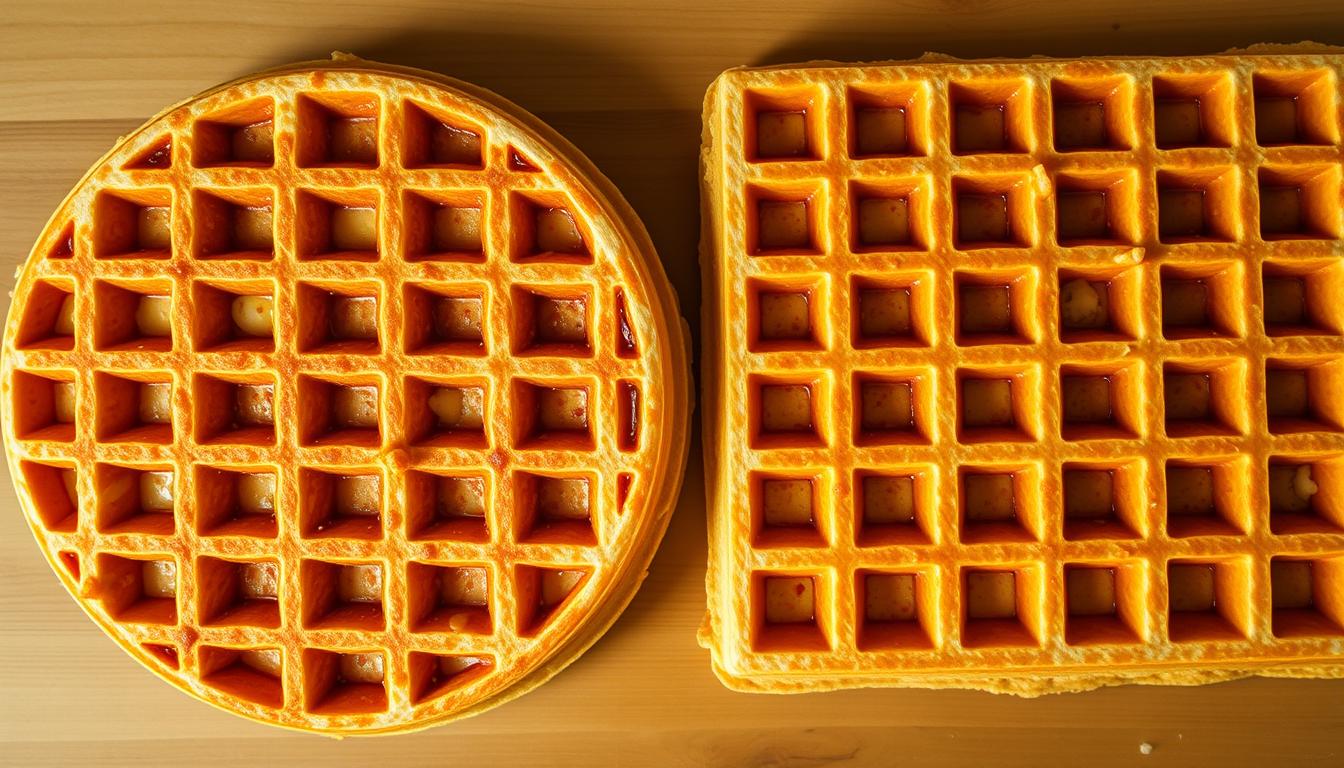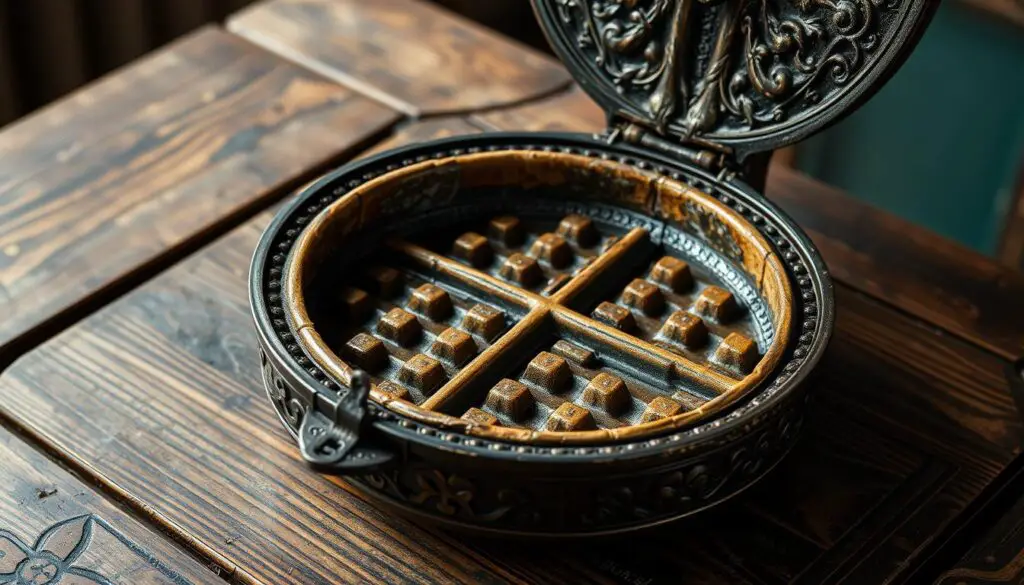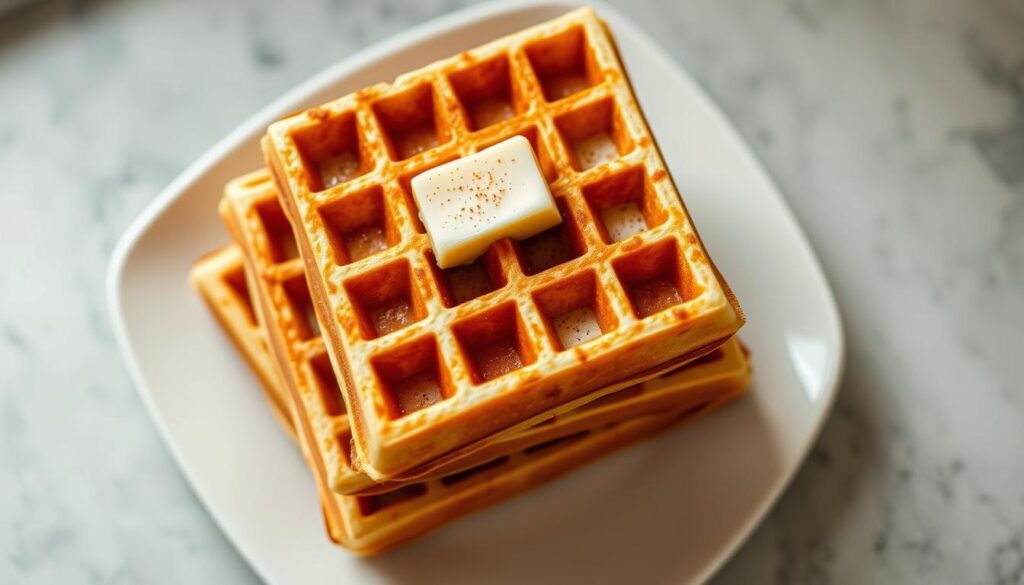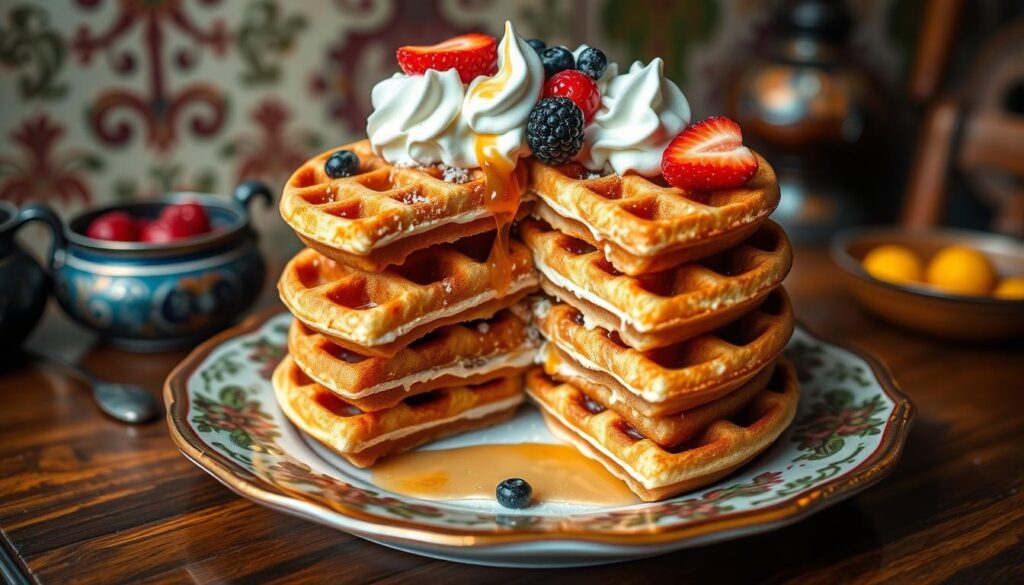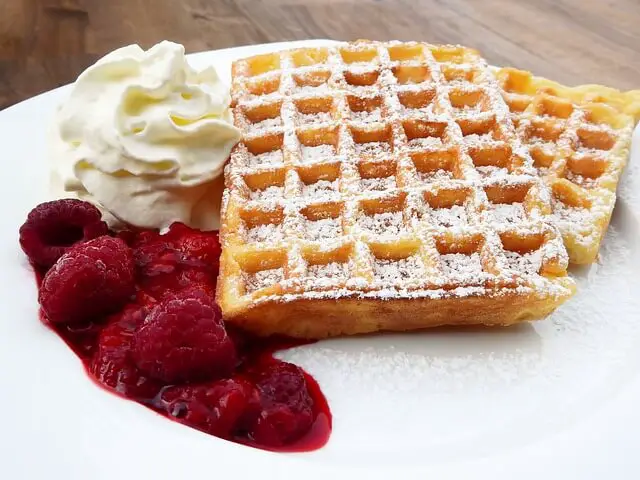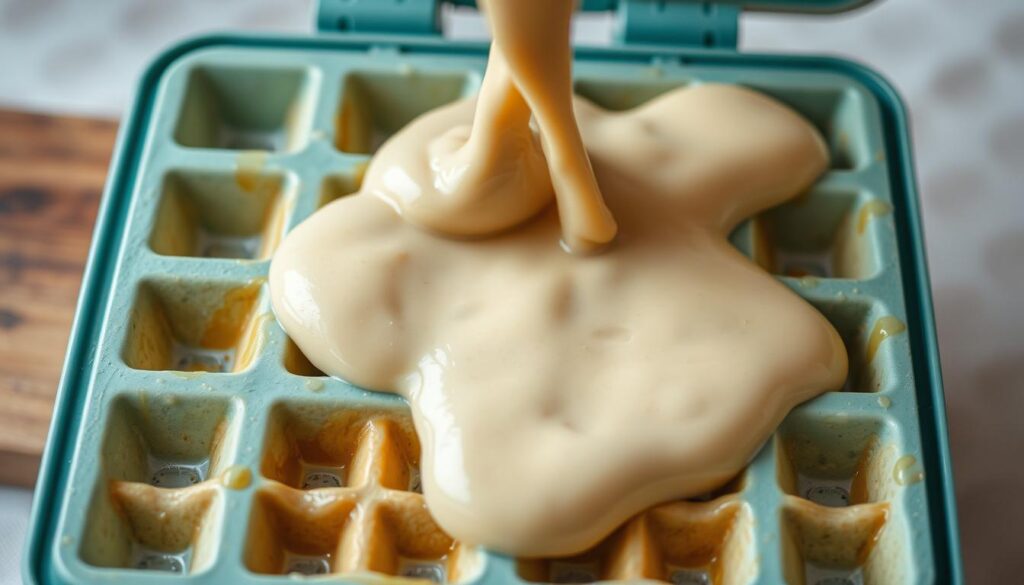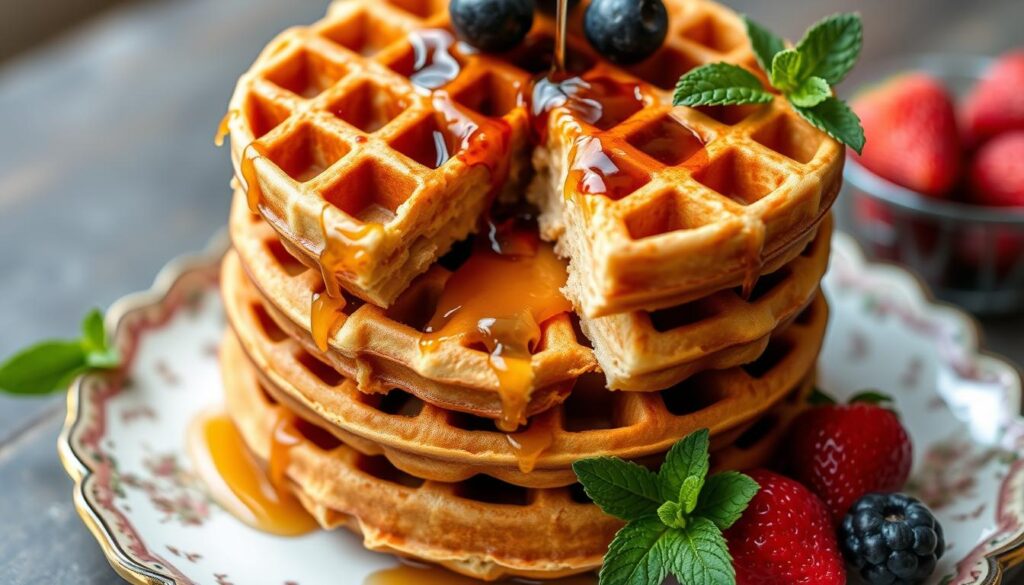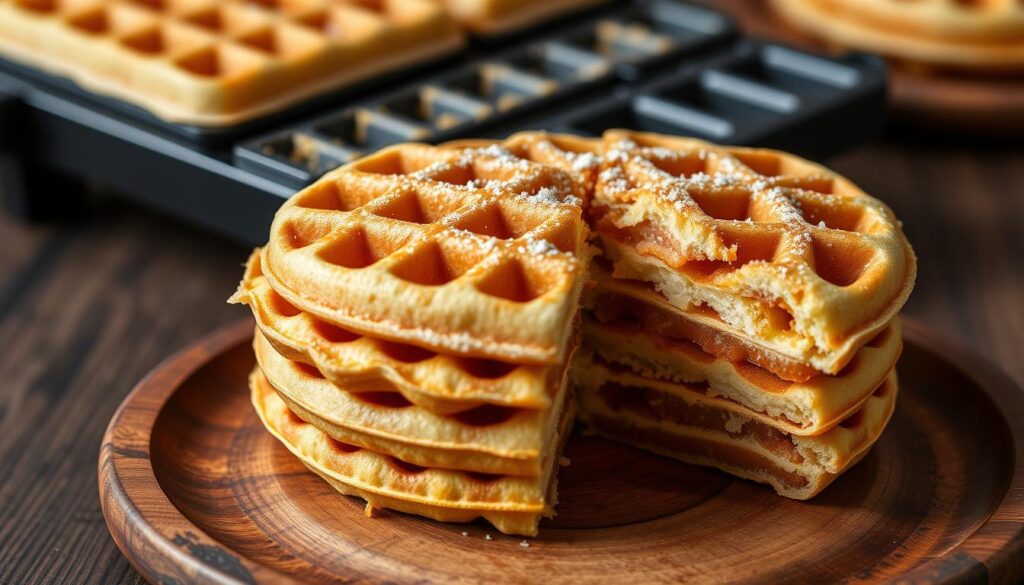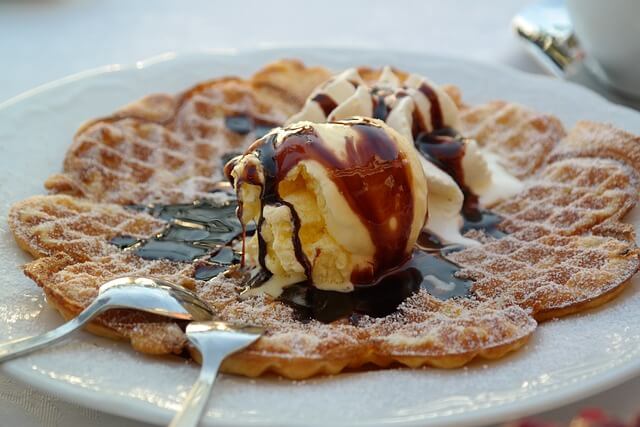Did you know there are over a dozen waffle types in Belgium alone? This shows the deep history of waffles but the waffle’s square pattern has not changed because it helps them cook more evenly and hold more toppings.
The waffle’s history started with ancient Greek flat cakes called obelios. The word “waffle” first appeared in English in 1725, but its roots go back even further.
Waffle irons changed waffle history in medieval Europe. By the 16th century, waffles looked like we know them today. Making thick waffles became easier with these irons, changing everyone’s breakfast routine everywhere.
In France, King François I had silver waffle irons, making waffles royal. The first waffle recipe was in the 14th century, starting a long history of recipes.
Key Takeaways
- Waffles originated from ancient Greek flat cakes called obelios
- The word “waffle” entered the English language in 1725
- Waffle irons with grid patterns emerged in the 16th century
- The first waffle recipe dates back to the 14th century
- Belgian waffles were introduced to America at the 1962 World’s Fair
- Over a dozen regional waffle varieties exist in Belgium alone
Table of Contents
- 1 The Evolution of Waffle Patterns: From Ancient Greece to Modern Times
- 2 The Science Behind Waffle Squares
- 3 Functional Benefits of Waffle Squares
- 4 Cultural Significance of Waffle Squares
- 5 The Physics of Waffle Making: Why Squares Work Best
- 6 Alternative Waffle Shapes: Comparing Squares to Other Designs
- 7 The Perfect Waffle Recipe: Leveraging the Square Design
- 8 Waffle Irons Through History: The Technology Behind the Squares
- 9 Health Considerations: Are Square Waffles Nutritionally Different?
The Evolution of Waffle Patterns: From Ancient Greece to Modern Times
Waffle history goes way back, starting in Greece about 4,000 years ago. These early waffles were nothing like the crispy, golden treats we love today. We will examine how our beloved breakfast waffle evolved.
Early Precursors to Waffles in Ancient Civilizations
In ancient Greece, people cooked flat cakes called obelios on hot metal plates. These were unlike today’s waffles, being unleavened and unsweetened. The idea of waffles spread across Europe, changing over time.
The Emergence of the Waffle Iron in Medieval Europe
Medieval waffles were a big step forward in waffle iron history. In the 9th and 10th centuries, the first communion wafer irons were made. By the 14th century, a waffle recipe was included in a French cookbook.
How the Square Pattern Became Standardized
In the 15th century, Dutch waffles used rectangular irons, starting the square pattern trend. France and Belgium soon followed with grid patterns, perfect for holding syrup and toppings. By the 16th century, the modern waffle shape we love today was born, especially at places like Waffle House.
| Year | Milestone |
|---|---|
| 2000 BCE | Ancient Greeks create obelios |
| 9th-10th century | Communion wafer irons appear |
| 14th century | First waffle recipe documented |
| 15th century | Rectangular waffle irons introduced |
| 16th century | Deeply gridded irons developed |
The Science Behind Waffle Squares
Waffle science shows us how this breakfast favorite works. The square pattern isn’t just for looks. It’s a very important factor for making an evenly baked and perfectly formed waffle.
Heat Distribution and Cooking Efficiency
The square pattern helps heat spread evenly. This ensures a golden-brown outside and a soft inside. It’s all about making crispy waffles just right.
Surface Area Maximization for Crispiness
The square shape has more edges for crunch. It makes waffles crispier than other shapes. Plus, it’s up to 90% efficient, beating round designs.
Structural Integrity and Batter Expansion
The waffle’s shape keeps it stable while cooking. It holds the batter in, so waffles stay even. This makes deep pockets for syrup and toppings.
Waffle design also inspires science. The ‘Waffle Method’ in cryo-electron microscopy uses a grid pattern. It shows waffle ideas are used in more than just cooking.
Functional Benefits of Waffle Squares
The square design of waffles is more than tradition. It’s a practical choice that makes waffles better. From holding syrup to easy serving, these benefits make square waffles a favorite for breakfast. Their grid pattern is more than just pretty. It’s practical too.
Syrup and Topping Retention
The square pockets in waffles hold toppings perfectly. Syrup, butter, and fruit compotes fit right in. This means every bite is full of flavor.
Portion Control and Easy Cutting
The grid design makes serving waffles easy. You can split the waffle into equal parts along the lines. This is great for serving a group.
Aesthetic Appeal and Presentation
Square waffles look amazing. Their uniform pattern is perfect for creative toppings. Chefs and home cooks love the professional look they add.
| Waffle Type | Waffles per Hour | Unique Feature |
|---|---|---|
| Standard | 20-35 | Versatile for various toppings |
| Belgian | 20-25 | Deeper pockets for more toppings |
| Brussels | 20-40 | Rectangular shape, crispy exterior |
| Liege | 20-40 | Pearl sugar caramelization |
Cultural Significance of Waffle Squares
The square shape we know today came from centuries of cooking. However, there have been slight changes in waffle patterns to show the creativity of local tastes and cooking traditions. From Belgian treats to American breakfasts, waffles delight people everywhere but they keep their iconic square shape while fitting local tastes.
Regional Variations in Waffle Patterns
Belgian waffles show the variety of waffle traditions. Brussels waffles are big and rectangular, great for toppings. Liège waffles are denser with caramelized sugar pockets. These differences show the rich waffle culture in different places.
Symbolism and Traditions
Waffle shapes often mean something special. In Belgium, wedding waffles have unique imprints with names and dates. This tradition shows the significance of waffles in celebrating life’s big moments.
Square Waffles: An Iconic Breakfast Food
Square waffles became popular in American breakfasts in the 1960s. Their grid pattern is now a comfort food symbol. It’s perfect for all sorts of toppings and flavors.
| Waffle Type | Characteristics | Traditional Toppings |
|---|---|---|
| Brussels Waffle | Large, rectangular, deep pockets | Soft butter, whipped cream |
| Liège Waffle | Dense, caramelized sugar pockets | Plain or light dusting of powdered sugar |
| American Square Waffle | Crispy exterior, fluffy interior | Butter, maple syrup, fruits |
The Physics of Waffle Making: Why Squares Work Best
Waffle physics is crucial to making a perfectly formed breakfast waffle. The square pattern of waffle irons isn’t just for looks. It’s a crucial factor in achieving crispy waffles with a fluffy interior.
Batter Flow and Distribution
The square grid design of waffle irons promotes even batter distribution. When you pour the batter, it spreads quickly across the surface, filling each square. This uniform coverage ensures consistent cooking and texture throughout the waffle.
Heat Conductivity and Metal Plates
Waffle irons use metal plates for their excellent heat conductivity. These plates transfer heat efficiently to the batter, cooking it evenly from both sides. The square grid pattern increases the surface area in contact with the batter, promoting faster and more uniform cooking.
Steam Release for Crispy Exteriors
The square design of waffle irons serves another important purpose: steam release. As the batter cooks, it releases moisture. The grid pattern allows this steam to escape, preventing sogginess and contributing to the formation of a crispy exterior. This balance of steam release and heat conductivity is essential for achieving the perfect waffle texture.
Understanding these principles of waffle physics can help you make better waffles at home. By using the right batter consistency and cooking temperature, you can take full advantage of your waffle iron’s design to create delicious, crispy waffles every time.
Alternative Waffle Shapes: Comparing Squares to Other Designs
Waffle shapes vary, each with its own charm. While square waffles are common, other designs bring new excitement to breakfast.
Round Waffles and Their Characteristics
Round waffles offer a fresh take on the classic square. They are thinner and crisper. Their round shape helps batter cook evenly.
Heart-Shaped and Novelty Waffle Makers
Novelty waffles make breakfast fun. Heart-shaped waffles are perfect for Valentine’s Day. You can also find waffles in shapes like stars and cartoon characters.
Why Squares Remain the Most Popular Choice
Despite many waffle shapes, squares are still the favorite. The classic grid pattern has many benefits:
- It keeps syrup in the pockets
- It’s easy to cut and portion
- Heat cooks evenly
- It looks familiar and appealing
Let’s compare different waffle shapes:
| Shape | Texture | Syrup Retention | Cooking Time |
|---|---|---|---|
| Square | Crispy outside, fluffy inside | Excellent | 4-5 minutes |
| Round | Thin and crispy | Good | 3-4 minutes |
| Heart-shaped | Varies by maker | Fair | 4-5 minutes |
While other shapes are fun, square waffles are still a breakfast favorite. They’re practical and always in style.
The Perfect Waffle Recipe: Leveraging the Square Design
Making the perfect square waffle is all about the right mix of ingredients and technique. The square design of a waffle iron is critical to getting those crispy waffles with fluffy centers we love.
Ingredients for Square Waffle Perfection
For eight 7-inch diameter, 1-inch thick waffles, you’ll need:
- 2 cups all-purpose flour
- 1 tablespoon baking powder
- 1/2 teaspoon salt
- 2 tablespoons sugar
- 2 large eggs
- 1 3/4 cups milk
- 1/2 cup vegetable oil
- 1 teaspoon vanilla extract
Achieving Crispy Edges and Fluffy Centers
The secret to perfect waffles is in the batter and how you cook it. Here’s how to do it:
- Mix dry ingredients in a large bowl
- Whisk wet ingredients in a separate bowl
- Combine wet and dry mixtures until just blended
- Let batter rest for 5 minutes
- Preheat your waffle iron
- Pour batter into the center, spreading slightly
- Cook until golden brown
Filling Your Square Waffle Iron
Filling your waffle iron right is very important for even cooking of both sides of your waffle. Pour batter into the center of your preheated waffle iron, letting it spread naturally. This recipe and technique combo will give you crispy edges and fluffy centers every time.
Waffle Irons Through History: The Technology Behind the Squares
Waffle irons have a long history, changing from simple tools to modern kitchen gadgets. This journey shows our creativity and love for crispy waffles.
Early Cast Iron Waffle Makers
Cast iron waffles started in medieval Europe. These irons had deep patterns and were heated over flames. The National Museum of American History has over 50 waffle irons from more than 300 years ago.
The Electric Waffle Iron Revolution
The electric waffle maker changed everything. In 1869, Cornelius Swartwout made the first stove-top waffle iron. General Electric then made the first electric one in 1911. This made waffles easy to make at home.
Modern Waffle Technology
Today’s electric waffle makers are amazing. They have non-stick surfaces, adjustable heat, and even smart features. Some can make waffles with millions of squares, unlike the old ones.
| Era | Waffle Iron Type | Key Features |
|---|---|---|
| Medieval | Cast Iron | Used over open flames |
| 1869 | Stove-top | First patented design |
| 1911 | Electric | GE’s first prototype |
| Modern | Smart Electric | Non-stick, temperature control |
Health Considerations: Are Square Waffles Nutritionally Different?
Square waffles aren’t healthier than other shapes. But, their design can change how you eat. The grid pattern helps with portion control and topping distribution, affecting your waffle nutrition.
Comparing square waffles to other breakfast options
When looking at a balanced breakfast, square waffles are different. A Matcha Cottage Cheese Protein Waffles stack has 251 calories and 25g of protein. This beats traditional waffles in protein, making it a more satisfying breakfast.
How the square shape affects calorie distribution
The square pattern spreads toppings evenly. This helps with portion control, as you’re less likely to overdo it in one spot. Remember, toppings greatly affect your waffle’s calorie count.
Strategies for making healthier square waffles
To make nutritious waffles, try this recipe for eight 7-inch diameter, 1-inch thick waffles:
Ingredients:
– 2 cups whole wheat flour
– 1 tablespoon baking powder
– 1/4 teaspoon salt
– 2 large eggs
– 1 3/4 cups milk
– 1/4 cup vegetable oil
– 1 teaspoon vanilla extract
Instructions:
1. Mix dry ingredients in a large bowl
2. Whisk wet ingredients in a separate bowl
3. Combine wet and dry mixtures until just blended
4. Preheat your waffle iron and lightly coat with cooking spray
5. Pour batter onto the center of the iron
6. Cook until golden brown and crisp
7. Serve with fresh fruit, a drizzle of pure maple syrup, or add protein-rich toppings like Greek yogurt or nut butter to make your waffles healthier.
